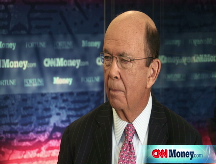Government debt prices churn
Treasurys mixed in the face of a record amount of supply headed through the pipelines and continued recession concerns.
NEW YORK (CNNMoney.com) -- Treasury prices churned Tuesday as investors weighed a tremendous amount of new debt coming to market with continued concerns about an economy mired in recession.
While trending downward in recent sessions as investors left the ultra-safe haven of Treasurys, government debt prices pulled off earlier lows late in the day.
The economy is still in a recession, and Treasurys are considered the safest place to keep funds.
"There is still a demand for Treasurys, and whenever prices cheapen up a little bit, we see some bargain hunters come back into the market," said Kim Rupert, fixed income analyst at Action Economics.
However, an onslaught of supply to fund the government's rescue of the U.S. economy pushed government debt prices lower in recent sessions and throughout the morning Tuesday.
Adding to the pressure on Treasury prices is the desire of investors to get a more profitable return on their investments.
"Equities are gathering a little bit of a bid, and that is helping some investors think that maybe it is time to put some money back to work in stocks or other assets," said Rupert.
Supply jolt coming: With President-elect Barack Obama's proposed new stimulus plan potentially costing as much as $775 billion and the total tab of the government's bailout approaching a whopping $8 trillion, the market for government debt is bracing for a tremendous volume of supply.
Treasury auctioned some $32 billion of government debt Tuesday, including $24 billion of 4-week bills and $8 billion worth of TIPS, or Treasury Inflation-Protected Securities. The principal of a TIPS fluctuates with inflation.
Rupert noted that the TIPS auction was very successful, and that was a positive for bond prices Tuesday. The 10-year TIPS auction posted a bid-to-cover ratio of 2.48.
"It shows there is appetite for Treasurys and we are going to need a big appetite to digest all the supply that is coming down the road," said Rupert.
The Treasury already sold $53 billion worth of short-term notes Monday. Looking forward, the Treasury this week still plans to auction $35 billion worth of 70-day cash management bills, $30 billion worth of 3-year notes, and it is re-opening $16 billion worth of 10-year notes.
The demand for ultra-safe government bonds outpaced supply in 2008, as investors looked to hide their funds from stock market volatility, and Treasury yields on all maturity notes fell to record lows. The yield on the 3-month Treasury bill hovered around zero for several weeks toward the end of the year, indicating that investors were simply looking for a safe haven for their assets.
Debt prices: The benchmark 10-year note reversed course to add 3/32 to 111-3/32 and its yield was 2.48%. Bond prices and yields move in opposite directions.
The 30-year bond dipped 7/32 to 128-9/32 and its yield rose to 3.04% from 3.01% Monday. The price of the long bond fell nearly 5 points Monday as investors dumped the longer maturity government Treasury and moved into other more profitable bonds, like municipals or high-grade corporate bonds.
Meanwhile, the 2-year note dipped 1/32 to 100-5/32 and its yield rose to 0.80% from 0.79%.
And the yield on the 3-month Treasury bill rallied to 0.14% from 0.09% late Monday. The 3-month Treasury bill is considered a gauge of confidence because investors shuffle funds in and out of the note as they assess the risk of the marketplace.
Lending rates: The 3-month Libor dipped to its lowest level since June 2004, edging down to 1.41% from 1.42% Monday, according to Dow Jones The overnight Libor rate, however, edged up to 0.13% from 0.12% Monday.
Libor - the London Interbank Offered Rate - is a daily average of rates 16 different banks charge each other to lend money in London. It is used to calculate adjustable-rate mortgages. More than $350 billion in assets are tied to Libor.
Meanwhile, two credit market gauges were mixed. One spread showed increased investor confidence, but another didn't budge.
The "TED spread," a measure of banks' willingness to lend narrowed to 1.27 percentage points from 1.33 percentage points late Monday. The lower the TED spread, the more willing investors are to take risks. The TED spread surged when the credit crisis hit the financial markets in September.
Another indicator, the Libor-OIS spread, held steady at 1.23 percentage points. The Libor-OIS spread measures how much cash is available for lending between banks, and is used for determining lending rates. The narrower the spread, the more cash is available for lending. ![]()





